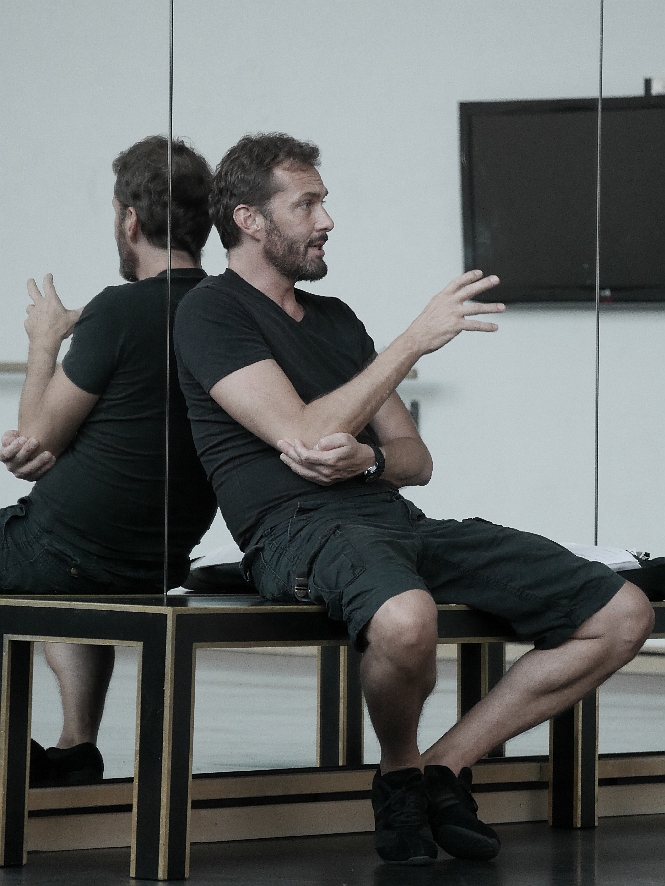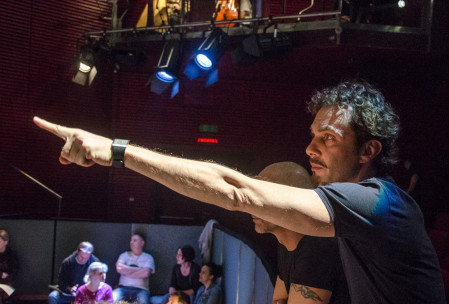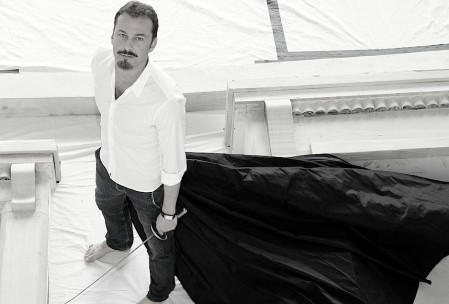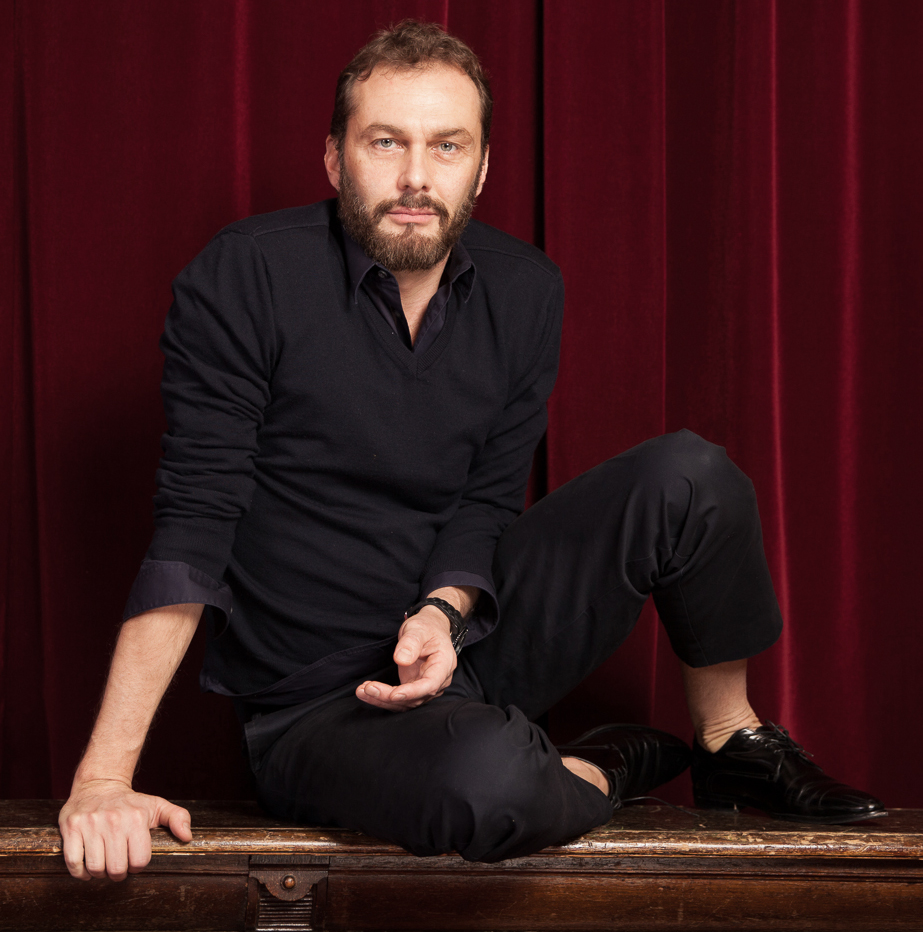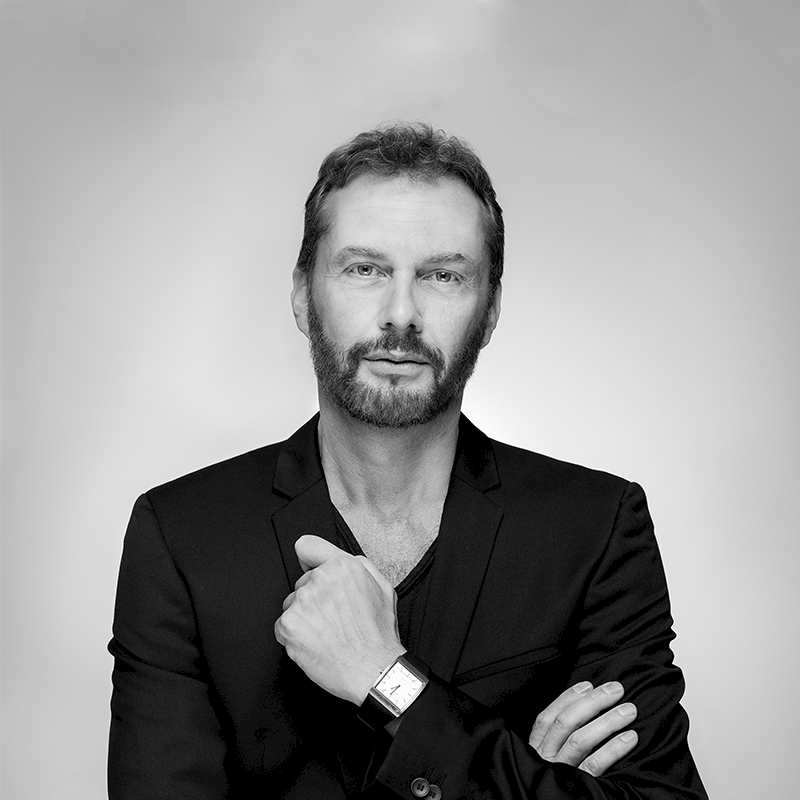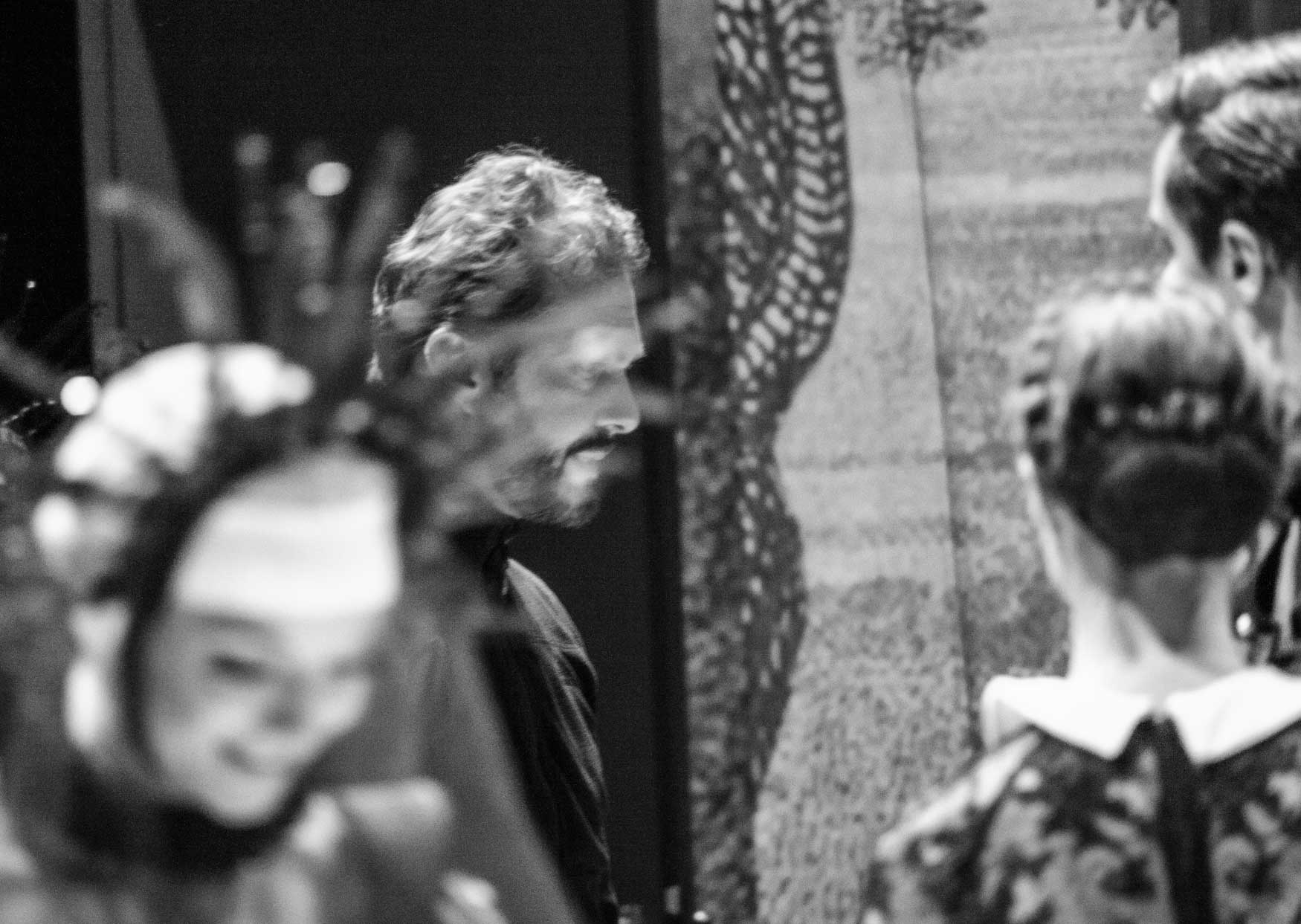BIOGRAPHY
Giorgio Madia graduated from the ballet school of Teatro alla Scala in Milan and was hired in the company and the end of his studies. He joined Maurice Béjart’s “Ballet du XXièmesiècle”, later “Béjart Ballet Lausanne” as Soloist Dancer. He was Principal Dancer with Pennsylvania Ballet, Milwaukee Ballet, San Francisco Ballet, Aterballetto and Zurich Ballet. Rudolf Nureyev invited him for his three years long world farewell tour to dance with him among others Maurice Béjart’s duet “Le Chant du compagnon errant” and José Limón’s “Moor´s Pavane”.
In 1997 Giorgio Madia concluded his dancing career, worked as First Ballet Master at Balletto di Toscana, Ballett Basel and BerlinBallett in the Komische Oper Berlin. He was Artistic Director for the Ballet of Teatr Wielki in Łodz and from 2003 to 2005 he was appointed Ballet Director and Chief Choreographer at the Wiener Volksoper.
In 1995 Giorgio Madia began choreographing and directing. The list of his work is extensive. Alongside the great classics of the ballet repertoire – “Sleeping Beauty”, “The Nutcracker”, “Swan Lake”, “Romeo and Juliet”, “La fille mal gardée” and “Coppélia” – are full-length dance works based on individual concepts: “Nudo”, “Alice’s Wonderland”, “Cinderella”, “OZ – The Wonderful Wizard”, “Chopin imaginaire”, “La Dolce Vita”, „Peter Pan”, “Pinocchio”, “Don Juan” and “Dangerous Liaisons”.
The essential features of his artistic style especially find their expression also in his work as stage director: musicality, sophistication, humour, a distinct visual signature and an intuitive sense for the magic moments of theatre. Among others he directed Offenbach’s “Tales of Hoffmann”, Bizet’s “Carmen”, Rameau´s “La Guirlande” and “Zéphyre”, Gluck’s opera-ballet “Orphée et Eurydice”, Jean Cocteau’s/Darius Milhaud’s “Le pauvre matelot” and musicals such as “Ain’t misbehavin’”, “Little Shop of Horrors”, “La Cage aux folles” and “Anatevka”.
Several times he was invited to work with Staatsballett Berlin, Kammeroper Wien, or Wiener Staatsballett for which he choreographed four years the opening of the Vienna´s Opera Ball. Repeatedly he has choreographed and directed the opening ceremony of the world famous “Life Ball” in front of Vienna City Hall, dedicating this work to charity. He has been awarded with the critic’s award “Golden Mask” Poland in 2005/06 (production of the year), 2006/07 (stage director and choreographer of the year) and 2007/08 (stage director of the year), in 2011 he was honored with the Premio Anita Bucchi (best light design) and the Premio Montepaschi „L’italia che danza” as choreographer of the year.
In 2016 he was invited by Béjart Ballet Lausanne to create a choreography inspired by the founder of the company. He has a long list of festivals that commissioned his work: in summer 2016 Salzburger Festspiele, with the co-staging and choreography of Gounod’s “Faust”, for Kammeroper Schloss Rheinsberg a new staging of “Carmen” in 2017 and ten years for the operetta festival Seefestspiele Mörbisch. Most recently Madia staged three key works of the operetta repertoire: “Die Fledermaus” for the Grand Theatre Lodz, “Wiener Blut” for the Estonian Theatre Vanemuine and “The Merry Widow” for the St. Petersburg State Musical Comedy Theater.
DOWNLOADS (click right mousekey after opening the link)
GIORGIO MADIA. THE PERMEATING POWER OF THE ELUSIVE
by Roberto Roesler | “The Scenographer”, December 2020
Dedicating an issue of a magazine that deals mainly with set design to a director who is also a choreographer has never been more appropriate than in the case of Giorgio Madia. From his first production in 1995 entitled STÜCK, a ballet created for a project for young choreographers of Zürich Ballett, there was keen interest in the visual impact of his show: a black and purple leitmotif for all the costumes and props he designed: a sailor, a tenor hanging from a grid dressed in Elizabethan attire, a dancer with a balloon wig, in a grotesque and dreamlike aesthetic. The success of this ballet earned him his first commission as choreographer at the Zurich Opera House. “As a child I played with big box cushions and I built furniture, rooms, and Spider convertibles, but above all stories. I feel like I’ve been doing this ever since,” says Giorgio Madia.
ORCHESTRATING THE STAGE DESIGN – VISUALS AND DIRECTING
The stage design and dramaturgical action within the show have, or should have, equal relevance. Lighting, the setting, costumes andacting, singing and dance must harmonize. Madia pays particular attention to the synergies of these elements but focuses above all onthe visual aspect so that for the audience it becomes a sensory, intellectual, rational and emotional experience. Madia is a directorobsessively involved in every single detail of the visual aspect far beyond its functionality and many set designers have experiencedfirsthand his meticulousness.
DYNAMIC SCENERY
The idea of moving scenery is as old as European theatre itself. In ancient Greek theatre, text, music, rhythm and dance were stagedusing mechanical devices, the “skene”, to position and move physical elements on stage. Giorgio Madia, thanks to his long experienceas an international dancer, has refined his sensitivity for movement and is extremely attentive to the dynamics of the technical elementsand therefore in his creative vision he uses all the inventive and technical possibilities that make it stand out. Madia is inspired byBaroque theatre and the Commedia dell’arte: the former has a spectacular and cumbersome engineering, the latter uses wagons andsimple backcloths. His stages evolve, they move and transform: at the opening of the curtain we witness a surprise, an illusion, a gameinside a magic box.
The latest and most obvious example of this implementation is A MIDSUMMER NIGHT’S DREAM, staged recently and now part of the repertoire of Krakow Opera: a blue baroque garden recreated with arches constantly maneuvered by the dancers who, to the rhythm of the music, create galleries, pavilions, mazes and forests. “A dancing set” that tends to astound through the dynamics as described in Lukasz Gazur’s critique for Gazeta Krakowska and Dziennik Polski.
LIGHTING DESIGN IS DIRECTION
Not influenced by age, gender or culture, colours have an impact on physiology by influencing moods, heart rate and circadian rhythms. Madia pays special attention to the use of colour.
As a light designer, Madia achieves the goal of unifying and coordinating the directing with costumes and set design. The focus on enhancing the scenery and costumes seals his collaboration with the design team. He favours neutral and cold colours to convey an idea of freshness and cleanness. The perception of cold colours induces a state of calm that counterpoints the fast pace of the stage action. This research defines his style. He conceives the lighting as a dramaturgic element that connects space with emotion, not only in the conventional sense, but with the precise purpose of influencing perception, the unconscious physical reaction and the psyche of the audience. His light design harmonizes, giving unity to the components of the show and is the sum of his productions.
CHOREOGRAPHY AND DIRECTING
Giorgio Madia is director and choreographer: “For me there is no separation between directing and choreography. I come from a dance background and I can’t help but think of a dynamic staging right from its very conception. Also because where words are not enough, the movement begins.”
Most musical scores contain composition for pure dance numbers, which unfortunately are quite often discarded as not all directors like to deal with this stage language with which they are not very familiar.
It’s always surprising how one of the essential elements of this genre — dance — receives so little attention and is underrated. It is not taken into account in the reviews and when artistic decisions are made for the production of musical theatre. The main focus is on the singers and the interpretation of the libretto – no doubt these elements are essential – but only occasionally, also on the artistic abilities of the performers. On the other hand, the dance element in an operetta, for example in those of Johann Strauss, is not only called for, but is indeed an integral part of the music and the libretto. Dance is the driving force. Madia masters the musical forms and gives a driving weight to every duet, every aria, every vocal number.
“DANCE IS THE MOST POWERFUL MEANS OF EXPRESSION OF THE HUMAN SOUL.” MAURICE BÉJART.
The influence of one of his first masters, Maurice Béjart, who understood the connection between gesture and dance, is undeniable. Béjart’s school at the Théâtre de la Monnaie in Brussels, where Madia worked early in his career as a dancer, was called “Mudra”, which in Hinduism, Jainism and Buddhism is a symbolic and ritual gesture, which at times involves the energy of the whole body or more often the hands or only the fingers.
Maestro Béjart’s indication that the simpler and more concise a movement the more clearly it is conveyed to the recipient, Giorgio Madia has come to make it his own. A clear sign is elegant and resonant of dance.
Hence the fruitful initiative to introduce sign language in the direction of the PARIETÉ GALA in Berlin, where Madia has been artistic director for six years. Here actors, singers, dancers and musicians of fame, of diverse genres, skills and disciplines create under his direction unique and galvanizing performances, in the theatre and outdoor stages in an annual nighttime event.
To stage pure play on stage, where set design and lighting act in concert with music and actors, requires a direction that goes far beyond the development of steps and formations. For this reason Giorgio Madia believes that choreography is also direction. Of his productions of musicals, shows, operettas and operas, which are based on the dance element, Madia is director but also choreographer.
Dance and movement are also the elements on which is based the largest European charity event LIFE BALL designed and directed by Madia and which takes place annually in front of the Vienna City Hall.
DIRECTING IN MUSICAL THEATRE
“Dance gives more life to music” Giorgio Madia.
Giorgio Madia’s first productions as director were of baroque operas and musicals before embarking on projects for opera productions and major events. DIE FLEDERMAUS, WIENER BLUT by Johann Strauss, and THE MERRY WIDOW by Lehar, respectively performed at the Teatr Wielki Lodz, the Estonian Vanemuine Theatre and the State Theatre of Musical Comedy in St. Petersburg, on the international scene are truly noteworthy. They were designed, staged and choreographed by Giorgio Madia who here too puts in motion soloists, choir and a large dance corps in large dance ensembles. The scenic elements have been created in such a way as to make this type of direction possible: light, refined and witty.
Entertaining, even elegant, it’s the whole design, the costumes a dream. Giorgio Madia aims to find and then spread the “scent”, the redolence of Strauss’s two operas and that of Lehar.
Unlike many of his contemporaries, he is faithful to the story, the original spirit of the opera and the era in which it was written. He captures the charm of the historical subject, not from a critical perspective but by admiring it and intensifying it with the necessary lightness and freshness. Uncompromising, with his “thinking in motion” he explores the depth of the supposed superficiality of these subjects while eschewing artificial and intellectual interpretations.
See for example WIENER BLUT whose captivating secret is a frenzy of colours and fragrant flowers, a sky of wisteria, delicate rotating scenic movements that frame intimate moments, slapstick scenes with a frantic rhythm, duets with gestures musically defined, ballet scenes of an airy beauty and the introduction of the very rare polka mazur “Die Libelle” op. 204 by Josef Strauss.
The naturalness of the performers is the result of a precise attention to the physicality and appearance of each artist. The large ensemble of soloists, ballet and choir that dances are the high points of all three operas. The idea of directing a stage production in a choreographed way and bringing dance, movement and gestures to all the actors, the choir and the corps de ballet in a total theatrical experience is of course not new – think of the great Erik Charell, who did the same with his work in musical theatre and revues, but few people share this idea of “Tanz-Regie” [dance direction] to the full. We hope to see more operettas staged to reclaim the spirit of this way of doing theatre because it enhances the expressive abilities of the artists and gives us a young, vital show, in tune with our time.
“It is important for me to also convey the ‘scent, the essence’. For me, it’s about creating images that give the audience the feeling of a special era and moment, triggering an emotional state that allows every single spectator to feel personally involved. There is an ineffable secret in the powerful moments of a good staging that is communicated instinctively and is built by describable elements; in fact, this is where movement comes in, it’s not just about steps and pirouettes, but about body language, the intention of a gesture, voice or breath and charisma – this is all choreography and, in a sense, even directing. This is the real power of theatre: to create an experience that exists with the sole purpose of becoming an exciting experience. In the manner of a drawing etched on the shoreline that is erased by the wave, what I create dissolves but the intention is that the emotion felt remains in the spectator.” (Giorgio Madia)
THE FESTIVE, THE ARCHAIC AND THE SPIRITUAL
“There is no theatre without the human person.” Giorgio Madia Ritual and entertainment are at the origin of theatre that is a world in its own right in which humans interact with each other, not only for actual “participation”, but for their subtle involvement. With Giorgio Madia’s directing, the audience is not just a witness to a magical moment, but it experiences it directly.
In Spain, an exhibition is often accompanied by the exclamation “Olé”, an exclamation that derives from the Arabic word “Allah” and expresses the spiritual experience that the public shares with the artists. Beyond the theory, this director demonstrates with his work the joyous life force of the theatre not as a “work of art” but as a celebration, an event, an explosion, a tension towards the sublime.

